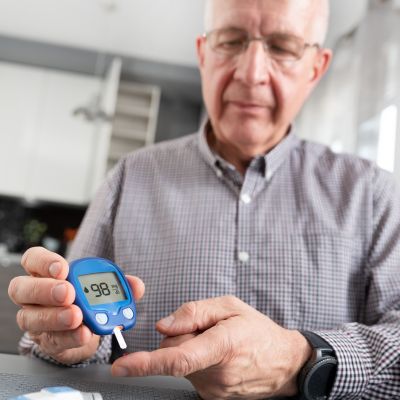Diabetic retinopathy is a serious complication of diabetes affecting the eyes that can lead to vision loss if left unchecked. However, there are proactive steps you can take to manage and control this condition. Implementing these strategies helps reduce your risk of progression and protect your vision.
Steps for controlling your symptoms include:
- Get a comprehensive eye exam on a regular basis
- Control your blood sugar levels
- Don’t smoke
- Exercise
- Maintain healthy cholesterol & blood pressure levels
What is Diabetic Retinopathy?
Also known as diabetic eye disease, diabetic retinopathy is a serious eye condition that affects people with diabetes. It occurs when high blood sugar levels damage the blood vessels in the retina, the light-sensitive tissue at the back of the eye. This damage can cause the blood vessels to leak fluid or bleed, leading to vision problems.
It may not have noticeable symptoms early on, but as it progresses, the disease can cause:
- Blurred vision
- Dark or empty areas in vision
- Difficulty seeing colors
- Blindness
Diabetic eye disease usually affects both eyes and becomes more likely the longer you have diabetes.
How to Control Your Symptoms
Managing diabetic eye disease requires a comprehensive approach. Regular eye exams with dilation are crucial for early detection and treatment. Controlling blood sugar levels is also essential, as high glucose damages retinal blood vessels. In addition, smoking accelerates the condition and complicates treatment.
Regular exercise helps manage symptoms by improving diabetes control and enhancing blood circulation. Healthy cholesterol and blood pressure levels also matter since they can worsen retinal damage.
Addressing these aspects can help:
- Slow the disease’s progression
- Preserve retinal health
- Maintain better vision
Being proactive is key for managing diabetic eye disease and its potential complications.
1. Get a comprehensive eye exam on a regular basis
Regularly scheduled comprehensive eye exams are crucial for detecting and managing diabetic retinopathy. These exams include a dilated eye exam that helps identify the disease early on before noticeable vision changes occur.
As the disease progresses, it may cause blood vessels to leak fluid. This can lead to:
- Diabetic macular edema
- Defective blood vessels
- Scar tissue
Early detection allows for timely treatment, which can slow or halt its progression. This can potentially prevent severe vision loss. Check-ups enable your eye doctor to monitor changes and adjust treatment plans accordingly. This helps safeguard your vision and overall eye health.
2. Control your blood sugar levels
High blood sugar damages the tiny blood vessels in the retina, making controlling blood sugar levels a crucial part of managing diabetic eye disease. By maintaining proper glucose control, you can slow the progression through the stages of diabetic retinopathy and reduce your risk of developing proliferative diabetic retinopathy.
Good glycemic control also discourages the growth of new, abnormal blood vessels. This can minimize the need for more invasive treatments for the disease. Regular monitoring of blood sugar levels allows for early detection and timely intervention.
3. Don’t smoke
Smoking speeds up the progression of diabetic retinopathy and complicates treatment by:
- Constricting blood vessels
- Reducing blood flow to the retina
- Accelerating damage to existing vessels
This can trigger the body to grow new blood vessels that are defective—a hallmark of the disease.
Smoking also increases inflammation and oxidative stress, further damaging retinal tissues. On the other hand, quitting can slow the disease’s progression and improves overall eye health. It also enhances the efficacy of treatments to help preserve your vision.
4. Exercise
Exercise helps control diabetic eye disease symptoms by improving overall diabetes management. Regular physical activity can lead to:
- Lower blood glucose levels
- Improve insulin sensitivity
- Enhance blood circulation in the retina
These effects can slow the progression of the disease and reduce the risk of developing severe forms of the disease.
Exercise also helps:
- Control blood pressure
- Reduce inflammation
- Improve lipid profiles
All of these factors contribute to better retinal health. Additionally, moderate aerobic exercise may decrease intraocular pressure, or the pressure of fluid inside of your eyes. This can potentially benefit ocular perfusion pressure, or the pressure at which blood enters the eye, and retinal blood circulation.
It’s important to talk to your doctor about appropriate exercise types and intensity. This is due to the fact that some activities may not be helpful if you have advanced retinopathy.
5. Maintain healthy cholesterol & blood pressure levels
High cholesterol can lead to the buildup of fatty deposits in blood vessels. This includes those in the retina, exacerbating damage caused by diabetic eye disease. High blood pressure also strains weakened vessels, increasing the risk of leakage and swelling.
Managing these factors reduces the stress on retinal blood vessels, slowing the progression of the disease. Low cholesterol and blood pressure levels help reduce the risk of these complications. This combined approach helps preserve your retinal health and maintain better vision.
Effective management of diabetic eye disease involves dilated eye exams for early detection. Blood sugar control and not smoking also help to prevent retinal damage. Regular exercise and maintaining healthy cholesterol and blood pressure levels are also crucial. This comprehensive approach helps slow disease progression, preserve retinal health, and maintain vision. The result is a reduced risk of severe complications.
Hardin Valley Eyecare & Optical has been serving Knoxville since 2009. Located at 10904 Spring Bluff Way, you can schedule an appointment online or call us at (865) 888-0892.
*Editor’s Note: This blog has been updated since it was originally published in August 2021






